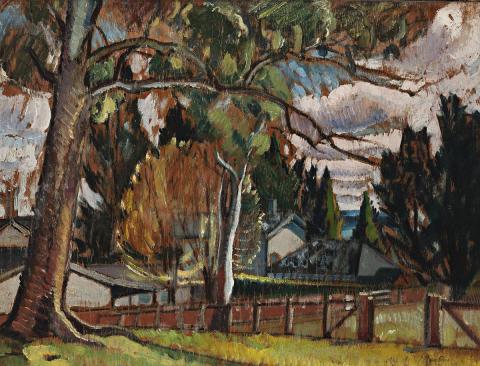LANDSCAPE, SUTTON FOREST, 1927
ROY DE MAISTRE
oil on plywood
33.0 x 43.5 cm
signed and dated lower right: R. de Maistre / 1927
inscribed on artist’s label verso: Landscape. Sutton Forest / by Roi de M … / Burdekin House / Macquarie St / Sydney / …
Mrs K. S. Hungerford, Greenwich
Christie’s, Melbourne, 28 April 1992, lot 8
Private collection
Lawrences Auctioneers, Crewkerne, United Kingdom, 25 May 2000, lot 503
The Estate of the late James O. Fairfax AC, New South Wales and Bridgestar Pty Ltd, Sydney
Artists Society of Canberra, Canberra [as stated in Christie’s, Melbourne, 28 April 1992 catalogue entry]
Antiques Trade Gazette, London, 13 May 2000, p. 35 (illus.)
The art of Roy de Maistre first came to prominence in the 1919 exhibition, Colour in Art, that was jointly presented with Roland Wakelin at Gayfield Shaw’s Art Salon in Sydney. Combining his dual interests in art and music, the small paintings displayed were based on a theory of colour-music developed by de Maistre and included the first abstract painting to be produced in Australia.1
In 1923 de Maistre was awarded the Society of Artists Travelling Scholarship, receiving an annual stipend of £250 for two years study in Europe. Moving between London and Paris, as well as travelling further afield, de Maistre’s paintings from these years reveal a young artist absorbing and learning from what he saw, experimenting with various styles and techniques to develop his own personal language.2 He exhibited at the Paris Salon in 1924 and showed work in the 1926 Venice Biennale, his paintings showing the marked influence of modern British art with his subjects depicted in a realistic if stylised manner.
Having returned to Australia the previous year, de Maistre held an exhibition of new paintings at Macquarie Galleries, Sydney, in 1926 and it was the landscapes that were singled out by the critic Basil Burdett as ‘the most interesting things shown. They had almost the value of a new vision … [and] hinted at what may be an interesting development in Australian landscape painting’.3 In September of that year Art in Australia published a special edition that heralded a ’new vision in Australian landscape’ and featured paintings by de Maistre, Kenneth Macqueen, Elioth Gruner and Daryl Lindsay, among others, who, using ‘simplification and reduction to essentials’ are ‘endeavouring to translate Australian landscape into the art of … the present day’.4
Sutton Forest, a small town near Moss Vale in the Southern Highlands of New South Wales was the subject of some of the paintings exhibited at Macquarie Galleries. Having spent his childhood in the area, de Maistre was familiar with the local landscape that is distinguished by its extensive plantings of introduced trees and temperate climate. A short distance from Bowral where James Fairfax lived at Retford Park, it is a landscape that he would have also known well. In this 1927 depiction of Sutton Forest de Maistre uses muted tones to describe a picturesque rural scene of houses and outbuildings framed on the left by a large tree in the foreground and offering a glimpse of low blue hills in the distance. The application of paint is lively and the clearly visible brushstrokes give the painting a sense of freshness and immediacy, suggesting that it may have been painted on one of the outdoor painting excursions to the area that de Maistre often took during these years.
1. Waterlow, N. and Pegus, A., Colour in Art – Revisiting 1919, exhibition catalogue, Ivan Dougherty Gallery, Sydney, 2008
2. Johnson, H., Roy de Maistre: The Australian Years 1894-1930, Craftsman House, Sydney, 1988, p. 49
3. Burdett, B., quoted in Johnson, H., ibid., p. 62
4. Editorial, Art in Australia, Sydney, 3rd series, no. 17, September 1926, pp. 5 – 6
KIRSTY GRANT
Former Director of Heide Museum of Modern Art
Former Senior Curator, National Gallery of Victoria
